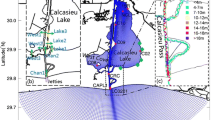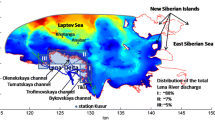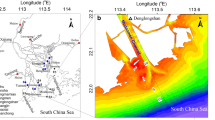Abstract
The behavior of a river plume in Suo-Nada, Japan, has been studied using a primitive equation numerical model, the Princeton Ocean Model. Special attention has been paid to the current structure and behavior of the anticyclonic eddy (bulge) induced by high freshwater inflow changing on a timescale of one week. First, the freshwater is supplied from a river to a rectangular basin with a simple topography. When the river discharge subsides after reaching its peak value, the bulge propagates upstream (i.e., opposite to the direction of the Kelvin wave propagation). Next, the freshwater is supplied from eight major rivers to the basin with realistic topography. The less saline water mass in the southern part of Suo-Nada propagates to the west (i.e., upstream) after the river discharge subsides. This is consistent with an observed phenomenon, viz., that the less saline water mass appears in the western part of Suo-Nada, suggesting that the upstream propagation of the bulge is possible in the real ocean. Finally, the cause of the upstream propagation is considered. Onshore currents appear in the bottom layer beneath the bulge, propagating upstream. They produce an anticyclonic barotropic eddy due to the conservation of potential vorticity. The current component associated with the eddy crosses normally to the isohaline in the upper layer, and therefore transports the bulge upstream. No other current component (such as surface current velocity minus vertically-averaged value) is responsible for the upstream propagation of the bulge.
Similar content being viewed by others
References
Balotro, R. S., A. Isobe and M. Simizu (2003): Seasonal variability in the circulation pattern and the residence time of Suo-Nada. J. Oceanogr., 59, 259-277.
Beardsley, R. C., R. Limeburner, D. Hu, K. Le and G. A. Cannon (1985): Discharge of the Changjiang (Yangtze River) into the East China Sea. Cont. Shelf Res., 4, 57-76.
Blumberg, A. F. and G. L. Mellor (1987): A description of a three-dimensional coastal ocean circulation model. p. 1-16. In Three-Dimensional Coastal Ocean Models, Coastal and Estuarine Sciences, 4, ed. by N. S. Heaps, AGU, Washington, D.C.
Bowden, K. F. (1983): Physical Oceanography of Coastal Waters. John Willy, 302 pp.
Chao, S.-Y. (1998): Hyperpycnal and buoyant plumes from a sediment-laden river. J. Geophys. Res., 103, 3,067-3,081.
Chao, S.-Y. and W. C. Boicourt (1986): Onset of estuarine plumes. J. Phys. Oceanogr., 16, 2,137-2,149.
Chapman, D. C. and S. J. Lentz (1994): Trapping of a coastal density front by bottom boundary layer. J. Phys. Oceanogr., 24, 1,464-1,479.
Construction Ministry's River Bureau (1986): The table of river discharge [Ryuryo-Nenpyo] (in Japanese).
Construction Ministry's River Bureau (1992): The table of river discharge [Ryuryo-Nenpyo] (in Japanese).
Fennel, W. and A. Mutzke (1997): The initial evolution of a buoyant plume. J. Mar. Sys., 12, 53-68.
Garvine, R. W. (1999): Penetration of buoyant coastal discharge onto the continental shelf: A numerical model experiment. J. Phys. Oceanogr., 29, 1,892-1,909.
Garvine, R. W. (2001): The impact of model configuration in studies of buoyant coastal discharge. J. Mar. Res., 59, 193-225.
Griffiths, R. W. (1986): Gravity currents in rotating systems. Ann. Rev. Fluid Mech., 18, 59-89.
Hickey, B. M., L. J. Pietrafesa, D. A. Jay and W. C. Boicourt (1998): The Columbia River plume study: Subtidal vari-Fig. 13. As Fig. 12 except for the surface current component without the vertically-averaged velocity. Current Structure and Behavior of the River Plume 843 ability in the velocity and salinity fields. J. Geophys. Res., 103, 10,339-10,368.
Isobe, A., M. Kamizono and S. Tawara (1993): An oxygen-deficient water mass in the southwestern part of Suo-Nada. Bull. Coast. Oceanogr., 31, 109-119 (in Japanese with English abstract).
Japan Meteorological Business Support Center: Meteorological Internet Service (http://www.jmbsc.or.jp/).
Kamizono, M., H. Ikeuchi and K. Terada (1988): Nutrient loads from the rivers surrounding the western part of the Suo-Sea. Reports of the Fukuoka-Buzen Prefectural Fisheries Experimental Station, 1, 131-135 (in Japanese).
Kamizono, M., A. Isobe, T. Etoh, S. Tawara and Y. Koizumi (1995): Formation mechanisms of oxygen-deficient water mass in the southwestern part of Suo-Nada-Factors affecting temporal fluctuation of oxygen consumption rate-. Bull. Coast. Oceanogr., 32, 167-175 (in Japanese with English abstract).
Kamizono, M., T. Etoh and H. Satoh (1996): Relationship between the oxygen-deficient water formation and meteorological in the southwestern part of Suo-Nada. Bull. Coast. Oceanogr., 33, 87-95 (in Japanese with English abstract).
Kourafalou, V. H. (1999): Process studies on the Po River plume, North Adriatic Sea. J. Geophys. Res., 104, 29,963-29,985.
Kourafalou, V. H., L.-Y. Oey, J. D. Wang and T. N. Lee (1996): The fate of river discharge on the continental shelf, 1, Modeling the river plume and inner shelf coastal current. J. Geophys. Res., 101, 3,415-3,434.
Magome, S. and A. Isobe (2002): An analysis of the river plume behavior in Suo-Nada, based on the classification of salinity data by the history of river discharge. Engineering Science Reports, 24, 195-198 (in Japanese with English abstract).
Magome, S., A. Isobe and M. Kamizono (2002): The response of the oxygen-deficient water mass to river discharge in Suo-Nada. Bull. Coast. Oceanogr., 40, 59-70 (in Japanese with English abstract).
Marine Information Research Center (2001): MIRC Ocean Dataset 2001 Documentation. 169 pp. (in Japanese).
Matsuno, T. and Y. Nagata (1987): Numerical study of the behavior of heated water discharged into the ocean, Part 1: the effect of earth's rotation. J. Oceanogr. Soc. Japan, 43, 295-308.
McCreary, J. P., S. Zhang and S. R. Shetye (1997): Coastal circulation driven by river outflow in a variable-density 1 1/ 2-layer model. J. Geophys. Res., 102, 15,535-15,554.
Mellor, G. L. (1990): User's guide for a three-dimensional, primitive equation, numerical ocean model, report. Atmos. Oceanic Sci. Program, Princeton Univ., Princeton, N.J., 44 pp.
Mellor, G. L. and T. Yamada (1982): Development of a turbulent closure model for geophysical fluid problems. Rev. Geophys. Space Phys., 20, 852-875.
Mertz, G. and D. G. Wright (1992): Interpretations of the JEBAR term. J. Phys. Oceanogr., 22, 301-305.
Minato, S. (1983): Geostrophic response near the coast. J. Oceanogr. Soc. Japan, 39, 141-149.
Oey, L.-Y. and G. L. Mellor (1993): Subtidal variability of estuarine outflow, plume, and coastal current: A model study. J. Phys. Oceanogr., 23, 164-171.
Senjyu, T., H. Yasuda, S. Sugihara and M. Kamizono (2001): Current and turbidity variations in western part of Suo-Nada, the Seto Inland Sea, Japan: A hypothesis on the oxygendeficient water mass formation. J. Oceanogr., 57, 15-27.
Sugimoto, T. (1982): Physical problems in the open coastal ocean. Bull. Coast. Oceanogr., 19, 121-130 (in Japanese).
Walker, N. D., G. S. Fargion, L. J. Rouse and D. C. Biggs (1994): The great flood of summer 1993: Mississippi River discharge studied. EOS Trans. AGU, 75, 409.
Weingartner, T. J., S. Danielson, Y. Sasaki, V. Pavlov and M. Kulakov (1999): The Siberian Coastal Current: A wind and buoyant-forced Arctic coastal current. J. Geophys. Res., 104, 29,697-29,713.
Yankovsky, A. E. (2000): The cyclonic turning and propagation of buoyant coastal discharge along shelf. J. Mar. Res., 58, 585-607.
Yankovsky, A. E., B. M. Hickey and A. K. M Ünchow (2001): Impact of variable inflow on the dynamics of a coastal buoyant plume. J. Geophys. Res., 104, 29,697-29,713.
Author information
Authors and Affiliations
Rights and permissions
About this article
Cite this article
Magome, S., Isobe, A. Current Structure and Behavior of the River Plume in Suo-Nada. Journal of Oceanography 59, 833–843 (2003). https://doi.org/10.1023/B:JOCE.0000009574.12925.16
Issue Date:
DOI: https://doi.org/10.1023/B:JOCE.0000009574.12925.16




